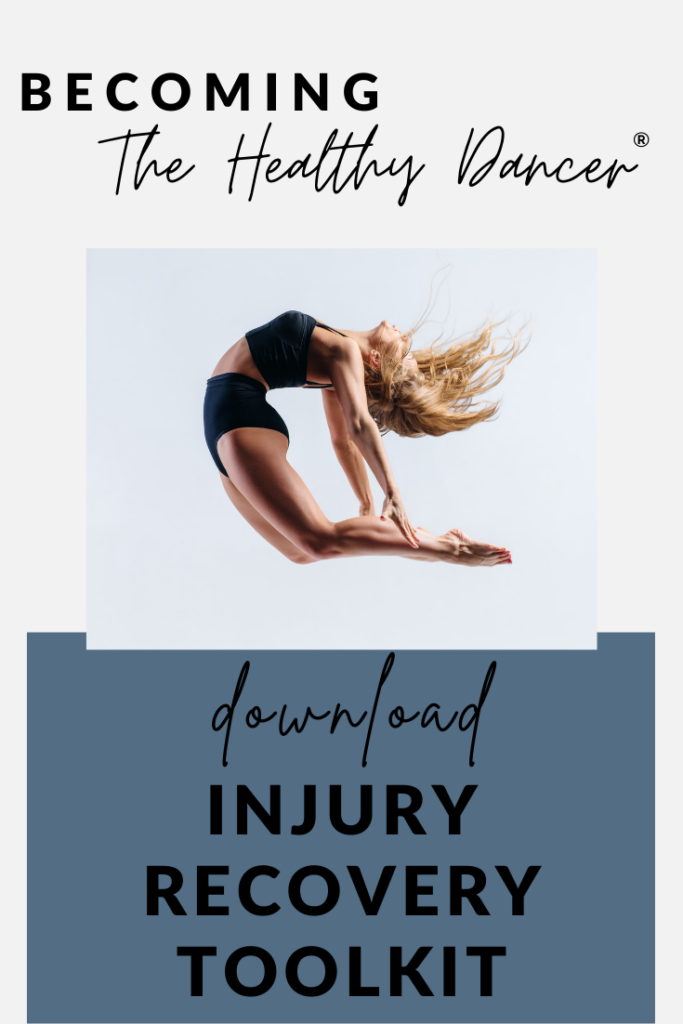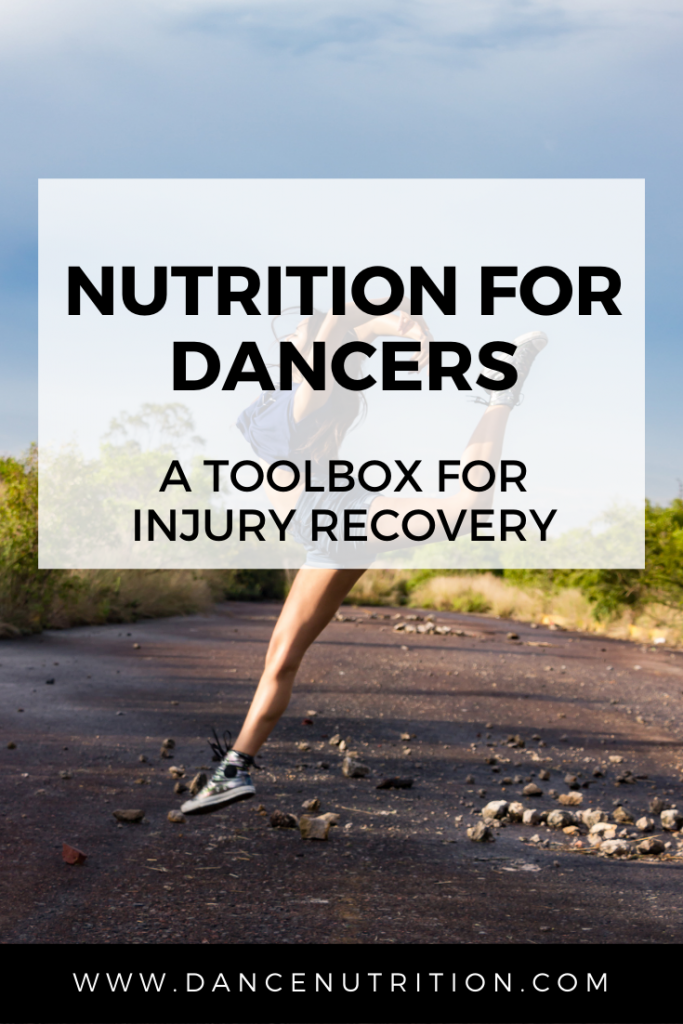Nutrition for performance is a critical aspect of a dancer’s life. But what about when we’re unable to perform? When dealing with an injury, dancers face physical, mental, and emotional distress. Proper nutrition, along with support and guidance, can help dancers navigate this trying time.
Building a recovery plan that supports a dancer’s physical, mental, and emotional well-being is essential for your return to the studio. To get you feeling your best, let’s build A Dancer’s Toolbox for Injury Recovery.
And don’t forget to grab your FREE downloadable toolbox below!
Nourish your recovery
When injured, dancers often feel a loss of control from what might typically be a structured routine. In attempts to regain some sense of normalcy, it’s common to desire control over other factors of life. Case in point(e): your diet. This usually translates into controlled eating habits or restrictive rules as a means to “prevent” weight gain while away from the studio.
The problem, however, is that the body’s recovery process requires nourishment in the form of calories and nutrients, both of which come from food. And while you might not be able to utilize your time in the studio right now, this can be an opportunity to listen and learn more about your body’s needs. Practice mindful eating techniques, and honor your intuitive hunger, fullness, and satisfaction cues at meals. Here are a few helpful articles to help you along the way:
But to further your body’s recovery, let’s break down a few key elements of your recovery nutrition toolbox:
The macronutrients of a dancer’s recovery
Balancing the three macronutrients from food: carbohydrates, protein, and fat is not just essential to your dancing fuel mix but is also important for your injury recovery. Each macronutrient is involved in specific metabolic processes that support your body’s ability to rebuild, repair, and rejuvenate.
Protein makes up the framework of our muscles. While some muscle loss is normal during the recovery process, incorporating high-protein foods throughout your day will help to combat extreme losses. Essential amino acids, the building blocks of protein, are obtained from both plant-based and animal-based food sources. While animal-based proteins such as meat, fish, eggs, and dairy are abundant in these amino acids, vegan dancers can obtain all essential amino acids from a plant-based diet. To learn more about a properly-planned plant-based lifestyle, consider downloading The Healthy Dancer® Survival Guide for plant-based diets. You can also learn more about protein for dancers here, along with a guide to protein powders.
We often consider carbohydrates as a dancer’s primary source of energy. However, they’re also essential to your body’s recovery process. Carbohydrates trigger the release of a hormone called insulin, which increases your muscles’ ability to absorb glucose for glycogen replenishment. This is why the carbohydrate-to-protein mix is critical for your recovery meal plan. Read this article to learn more about the various types of carbohydrates in your diet.
Intense exercise, such as dancing, is known to contribute a certain level of oxidative stress to the body. While low levels are normal, chronic stress can accumulate into inflammation and even lead to impaired immunity. Fats, especially unsaturated fats and omega-3 fatty acids are known for their anti-inflammatory properties. Omega-3 fats may even reduce soreness. Omega-3 fatty acids are essential, meaning they can’t be produced by the body and must be consumed in the diet. The two key forms of omega-3 fats are DHA and EPA. Food sources rich in DHA and EPA include fish such as salmon, herring, mackerel, sardines, & trout. Plant sources, such as walnuts, chia, avocado, and ground flax are rich in another form of omega-3, ALA, which the body can convert to EPA & DHA.
The micronutrients of a dancer’s recovery
When it comes to dancer nutrition, I often stress the importance of a food-first approach. This is especially true for both post-class recovery and long-term injury recovery. Unlike supplements, food comes naturally packaged with an array of vitamins, minerals, and phytonutrients. These micronutrients not only support the body’s metabolic demands but also play key roles in immune defense and structural rebuilding. Let’s take a closer look:
Our bones are reservoirs of calcium, a mineral that makes up much of the framework of our skeleton. Since the body is constantly rebuilding and remodeling bone, it’s important to supply enough calcium from our diet. Calcium also plays a role in blood clotting, which is important when recovering from injury or surgery. Food sources of calcium include milk, yogurt, cheese, fortified soy products, nuts, chia, green veggies, and dried fruit. Vitamin D works alongside calcium, promoting its absorption. Technically a hormone, vitamin D even plays a role in reducing inflammation. Our body can synthesize vitamin D from the sun, but you can also find it in fatty fish like salmon and tuna, egg yolks, and mushrooms.
Phosphorus also supports the process of bone formation and even plays a role in energy metabolism. Food sources include milk, yogurt and cheese, bread products, dark chocolate, and meat.
Magnesium preserves muscle and nerve function, energy metabolism, and bone strength. Food sources include nuts and seeds; legumes; leafy, green vegetables; seafood, chocolate; and artichokes.
Iron is a mineral that maintains blood health, aiding in the transport of oxygen throughout the body. Iron is found in red meat, eggs, cereals, green veggies, nuts, legumes, and dried fruit. Zinc is also a mineral but with a priority to aid in wound healing. Zinc also supports immune function and can be obtained from meat, seafood, green veggies, dark chocolate, and seeds.
Vitamin E and vitamin C are technically antioxidants, which help to alleviate cellular damage from both intense exercise and injury. Alongside other antioxidants, these vitamins support a strong immune system. When it comes to obtaining these nutrients from the diet, aim for variety and abundance of colorful plant-based foods, such as a rainbow of fruits and veggies. The daily requirement for vitamin C is just 45–100 milligrams. To optimize your body’s absorption of vitamin C, eat small servings throughout the day: an orange at breakfast and chopped bell peppers with your afternoon snack. Vitamin A also acts as an antioxidant, supporting healthy bones, and skin, along with preventing cellular damage. Vitamin K plays a role in tissue healing and supports bone strength. To learn more about the different sources of each, check out my 7-day free trial, which dives into a dancer’s micronutrient needs, and download your free toolbox for injury recovery below.
The importance of hydration
Water accounts for 60% of the total weight of the human body and is the medium of which our body’s cells thrive. In regards to recovery, water aids in the removal of waste products that can build up from physical stress and even medication usage. It is vital to stay hydrated even when not physically dancing.
Consider a team approach
Time away from the studio can be difficult to manage (read more about how I get through these tough times). Building a support system is essential during your injury recovery process. Reach out to a mental health therapist, physical therapist, and Registered Dietitian Nutritionist to build a team that supports your mental, physical, and emotional progress. Given the specific needs of our art, I recommend choosing licensed professionals with a background in dance. For more help, check out my dancer-approved list of resources.
Recovery beyond food and meal plans
Once you’re cleared to return to dancing, consider your approach. It’s unlikely that you’ll be able to return to dancing at the same intensity and duration before your injury. Start slow and reduce your expectations— pushing through pain is never recommended. Give your body the time needed to regain strength and stamina. You might experience more soreness afterward and be out of breath even after the simplest of movements. This might also be a time when you’ll need more stretching before dancing, and recovery activities like foam rolling afterward.
Make space for frustration— it is very valid to feel upset during this time. Your level of soreness and fatigue might also exacerbate this frustration. If you’re feeling like these experiences are preventing you from progressing, then consider a perspective shift. This often means actively swapping self-critical judgment with self-compassion. Here’s an example:
Identify a thought like, I should be able to beat my petit allegro without feeling winded… I’m so out-of-shape!” and swap it with It makes sense why I’m winded… I had to take time off from petit allegro and rebuilding my stamina takes time.” Here’s an article that dives more into helpful tips for returning to the studio after an injury.
Consider non-dance-related activities to help rebuild stamina
If you’re continuously feeling triggered in the studio— frustrated by your recovery limits and doubtful of your progress, then consider non-dance activities to help the process. Pending clearance with a physical therapist, low-impact activities like walking, yoga, pilates, and gyrotonics might be helpful.




